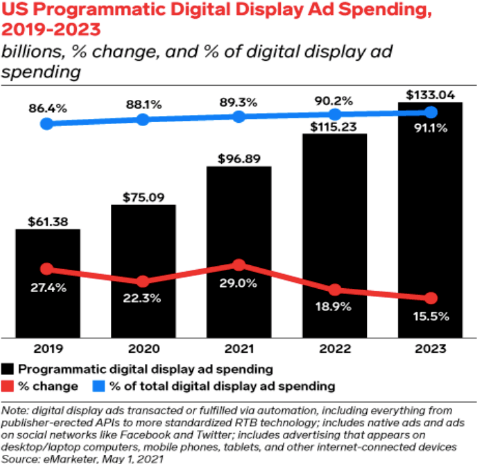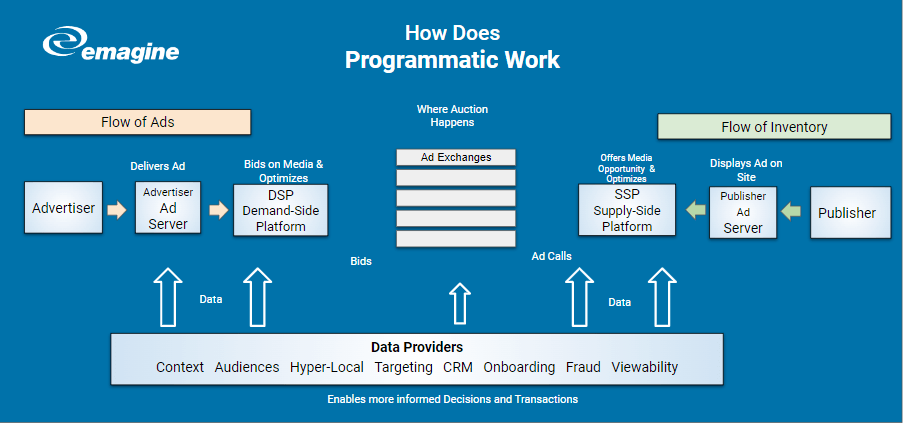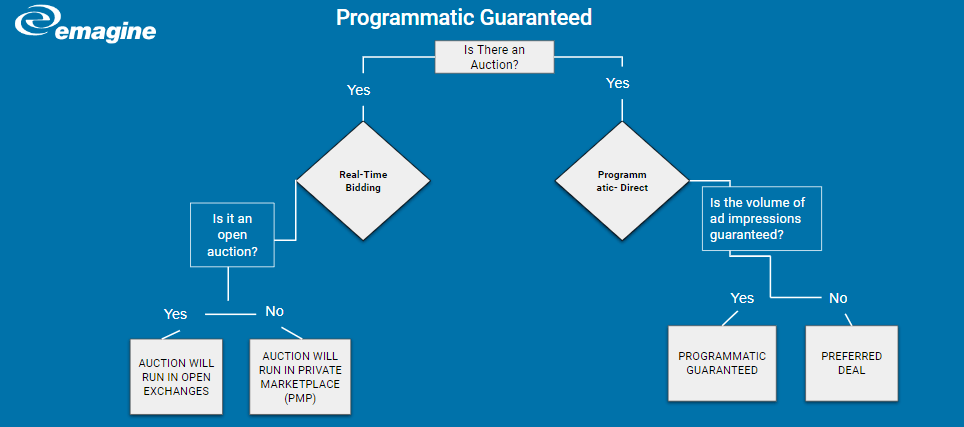Basic Google Ads to Programmatic: A Guide for Small to Midsize Pharma and Life Science Firms

In the ever-evolving digital advertising landscape that is expected to grow to over $133B in 2023 at over 15% year over year, programmatic advertising has emerged as a powerful tool for businesses looking to reach their target audience precisely and efficiently. This is especially true for small to mid-size pharma and life science companies operating in highly regulated industries and adhering to strict advertising guidelines.
We will provide a comprehensive guide for small to mid-size pharma and life science companies on transitioning from essential Google Ads to programmatic advertising.

Importance Of Programmatic Advertising For Small To Mid-Size Pharma And Life Science Companies
Programmatic advertising has become an essential tool for businesses of all sizes, and small to mid-size pharma and life science companies are no exception. These companies operate in highly regulated industries and face strict advertising guidelines, making it difficult to reach their target audience with traditional advertising methods.
Programmatic advertising enables these companies to reach their target audience precisely and efficiently, ensuring their message is delivered to the right people at the right time. It also allows them to optimize their advertising campaigns in real-time, maximizing their return on investment (ROI) and ensuring that their marketing budget is used effectively.

Types Of Programmatic Advertising
There are three main types of programmatic advertising: real-time bidding (RTB), programmatic direct, and private marketplaces.
Real-Time Bidding (RTB)
Real-time bidding, often known as RTB, is a method that allows many advertisers to compete with one another for the right to display their advertisements on your website. This type of marketplace can be a source of demand. Sell-side platforms, also known as SSPs, are typically utilized by publishers in order to connect to many ad exchanges at the same time and sell their impressions in a manner that is automated through the usage of real-time bidding protocol. Real-time bidding may take place in a variety of settings depending on the circumstances. Header Bidding, Ad Exchanges, or Private Auctions are all viable options for carrying it out.
Programmatic Direct
Programmatic directly involves buying ad inventory directly from publishers on a guaranteed basis, bypassing the auction process. This is typically used for premium inventory or campaigns with specific targeting requirements.
Private Marketplaces
Private Marketplaces (PMP), often known as Private Auctions, are another name for private sales. In this scenario, the publisher makes the inventory available to a limited number of advertisers for bidding before it is made available to all buyers in the open marketplaces.
Ad Exchanges
Ad Exchanges create an open market environment in which many publishers sell their ad inventory to numerous purchasers who are bidding for these inventories. Ad Exchanges are also known as “ad markets.” In a similar manner to the stock market. You can simplify things by saying that it is an upgraded version of ad networks; however, you should be aware of the specific changes.
Header Bidding
Heading Bidding is an innovation that takes the bidding on ad exchanges to the next level. Through the use of header bidding, you are able to connect to and receive bids from a number of different demand partners (exchanges/SSPs) all at the same time, which further increases the level of competition for your inventory. When there is more competition, there are more bids, and when there are more bids, there is more advertising money. The highest bidder in any of these situations is awarded the privilege of having their advertisement displayed.
When you access a webpage in the modern era, an ad server is the one responsible for delivering the advertisements that display in front of you to the ad units on the page. The ad server makes the decision as to which of the several available advertisements should be displayed to you (usually depending on the price that the advertisement would pay for the impression). In addition to providing advertisements, the ad server is capable of doing a variety of difficult jobs.
In a nutshell, an ad server makes it possible to create ad space, manage advertising campaigns, and improve their effectiveness. The ad server will receive all of the bids from demand partners, regardless of whether they came through the Open Marketplace or the Private Marketplace. The server will then make the final selection and deliver the advertisement to the user.
The question is, what compels the demand partners to place bids on each and every inventory? What characteristics distinguish one ad spot from another in terms of its value? The correct response is “User Data.” If you have a new drug, it is far more beneficial to display your advertisements to users who have an interest in the condition they need treatment than it is to display your advertisements to users whose primary interest is gardening. As a result, it makes perfect sense to place a greater bid for the first user than for the second user.
Therefore, both publishers and advertisers need access to user data in order to identify and target users. This is where data management platforms, also known as DMPs, come into play. DMP follows the user across many websites and collects data about the user in order to better understand the user’s interests. After that, this data is utilized to display relevant advertisements to relevant users. Please keep in mind that the DMP is not the only source of data that can be targeted; CDPs, CMPs, and even SSPs all contribute significantly to the targeting process because they all place cookies on the devices used by users in order to identify those users later.
You must have noticed the buyers bidding, targeting with data, sending creatives, etc. during the entire process. On the side of the purchasers, the utilization of Demand Side Platforms, or DSPs, is what makes all of these processes possible.

Transitioning from Google Ads to Programmatic Advertising
There are several signs and indications that you may be ready to graduate from Google Ads or social media advertising to programmatic advertising. These signs may include:
- Need for precise audience targeting
If a business has a specific audience that it wants to target with its advertising, programmatic advertising may be a more effective solution. Programmatic advertising enables businesses to precisely target their audience, using data to deliver personalized messages to the right people at the right time.
- The desire for greater efficiency and automation
Programmatic advertising is more automated than basic Google Ads or social media advertising. Automating digital advertising buying, placement, and optimization can save businesses time and resources. This enables businesses to focus on other areas while achieving their marketing goals.
- Need for real-time optimization
Programmatic advertising enables businesses to optimize their campaigns in real-time, ensuring that their advertising budget is used effectively and delivering a higher return on investment than traditional advertising methods. This is particularly important for businesses with a limited advertising budget, ensuring that their spend is used effectively.
- Need for access to premium inventory
Programmatic advertising enables businesses to access premium inventory through private marketplaces or programmatic direct. This can be particularly valuable for businesses that operate in highly regulated industries, such as pharma and life science companies, as it enables them to reach their target audience in a controlled environment and negotiate favorable rates.
- The desire for cross-channel integration
Programmatic advertising can be integrated with other marketing efforts, such as SEO, content, and email marketing, to create a cohesive and effective marketing strategy. This can be particularly valuable for businesses that want to ensure their advertising efforts align with their overall marketing strategy.
Programmatic Use Cases
To determine whether a business is ready to graduate from basic Google Ads or social media advertising to programmatic advertising, businesses should consider their data points and business needs. Some potential use cases for programmatic advertising may include:
- Targeting a specific audience
Programmatic advertising can be particularly effective for businesses that need to reach a specific audience, such as healthcare professionals or patients with a particular condition. By using data to deliver personalized messages to the right people at the right time, programmatic advertising can help businesses connect with their target audience on a more meaningful level.
- Optimizing advertising spend
Enables businesses to optimize their campaigns in real-time, ensuring that their advertising spend is used effectively and delivering a higher ROI than traditional advertising methods. This can be particularly valuable for businesses with a limited advertising budget and must ensure that their spend is used effectively.
- Increasing brand awareness
Increase brand awareness by delivering targeted messages to a specific audience. By using data to identify the interests and behavior of their target audience, businesses can create ad creatives tailored to their audience’s needs and preferences, increasing the chances that they will engage with their brand.
- Generating leads
Generate leads by delivering targeted messages to users interested in a particular product or service. By retargeting users who have visited their website or engaged with their brand on social media, businesses can deliver personalized messages that are designed to convert users into leads.
- Driving website traffic
Drive website traffic by delivering targeted messages to users most likely to be interested in a particular product or service. By optimizing their campaigns in real-time and using data to identify the most effective ad creatives, businesses can drive more traffic to their website and increase their chances of converting users into customers.
Understanding Programmatic Advertising
Definition of Programmatic Advertising
Programmatic advertising uses software to automate digital advertising buying, placement, and optimization. It enables advertisers to target their audience precisely and efficiently, using data to deliver personalized messages to the right people at the right time.
The need for available advertising space might manifest itself in a variety of ways.
It is possible for it to originate from a solitary advertiser in which the publisher has negotiated a direct transaction. The term “Programmatic Guaranteed” refers to a direct transaction in which the publisher promises to supply a specified volume of ad impressions and the advertiser agrees to buy it at a predetermined cost per thousand impressions.
Identifying Campaign Goals
The first step in transitioning from Google Ads to programmatic advertising is identifying your campaign goals. This will help you determine the key performance indicators (KPIs) you will use to measure the success of your campaign.
Common campaign goals for pharma and life science companies include increasing brand awareness, generating leads, and driving website traffic. Depending on your goals, you may need to prioritize different targeting methods and ad formats.
Conducting Market Research
Once you have identified your campaign goals, you must conduct market research to identify your target audience, analyze your competition, and perform keyword research.
Identifying your target audience is critical to the success of your campaign. Depending on your product or service, this may include healthcare professionals, patients, or caregivers. Analyzing your competition can also provide valuable insights into their marketing strategies and help you identify opportunities to differentiate your brand.
Keyword research will help you identify the search terms that your target audience is using to find information related to your product or service. This will inform your targeting strategy and help you create effective ad copy and design.
Creating a Budget and Allocating Resources
Creating a budget and allocating resources is the next step in transitioning from Google Ads to programmatic advertising. You need to determine your campaign budget and allocate resources effectively to ensure that you achieve your campaign goals.
When determining your campaign budget, you need to consider factors such as the size of your target audience, the competitiveness of your industry, and the ad formats you will be using. Allocating resources effectively involves identifying the channels that will deliver the highest ROI and optimizing your campaigns in real-time to ensure that your budget is used effectively.
Crafting Effective Ad Copy and Design
Crafting effective ad copy and design is critical to the success of your programmatic advertising campaign. You must follow legal guidelines, focus on benefits rather than features, and utilize visual elements to capture your audience’s attention.
Legal guidelines for pharma and life science advertising are strict, and you must ensure that your ad copy and design comply with regulations such as those from the FDA. Focusing on benefits rather than features is important because it helps you connect with your audience emotionally and highlight the value of your product or service. Finally, visual elements such as images and video can capture your audience’s attention and increase ad engagement.
Best Practices for Programmatic Advertising for Small to Mid-Size Pharma and Life Science Companies
Utilizing Retargeting Campaigns
Retargeting campaigns can be a powerful tool for pharma and life science companies, enabling you to deliver personalized messages to users who have already interacted with your brand. This can increase engagement and conversion rates, as users are more likely to respond to messages tailored to their interests and behavior.
To set up a retargeting campaign, you need to identify the users you want to target, such as those who have visited your website or engaged with your brand on social media. You can then create ad creatives tailored to these users’ behavior, such as highlighting products or services they have previously shown interest in.
Localizing Campaigns for Different Regions
Pharma and life science companies often operate in multiple regions, each with a unique cultural and regulatory environment. To ensure that your programmatic advertising campaigns are effective in each region, you need to localize your campaigns to reflect each audience’s specific needs and interests.
This may involve creating separate campaigns for each region, with ad creatives tailored to each region’s specific language, culture, and regulatory environment. You may also need to adjust your targeting strategy to reflect the unique characteristics of each region, such as targeting healthcare professionals in one region and patients in another.
Integrating Programmatic Advertising with Other Marketing Efforts
Programmatic advertising can be integrated with other marketing efforts, such as SEO, content marketing, and email marketing, to create a cohesive and effective marketing strategy.
SEO Integration
SEO involves optimizing your website to improve search engine rankings and increase organic traffic. By integrating programmatic advertising with your SEO efforts, you can deliver targeted messages to users who are already interested in your product or service, increasing their chances of engaging with your brand.
Content Integration
Content marketing involves creating valuable, informative content to attract and engage your target audience. By integrating programmatic advertising with your content marketing efforts, you can deliver targeted messages to users who have already shown an interest in your content, increasing the chances that they will engage with your brand.
Email Integration
Email marketing involves sending targeted messages to users who have opted-in to receive communications from your brand. By integrating programmatic advertising with your email marketing efforts, you can deliver personalized messages to users based on their behavior, increasing their chances of engaging with your brand.

Common Programmatic Platforms
Google Ads and DV360
Google Ads is a basic programmatic advertising platform enabling businesses to create and manage digital advertising campaigns. DV360 is a more advanced programmatic platform that offers a range of targeting options and optimization features.
- Pros: Google Ads and DV360 are easy to use and offer a wide range of targeting options. They are also relatively affordable and offer real-time optimization features.
- Cons: Google Ads and DV360 are limited in inventory and targeting options compared to other programmatic platforms. Additionally, there may be restrictions on the types of ads that can be run on these platforms due to regulatory requirements.
The Trade Desk
The Trade Desk is a programmatic advertising platform that offers a range of targeting options, including device targeting, location targeting, and audience targeting.
- Pros: The Trade Desk offers a wide range of targeting options and real-time optimization features. It also offers a user-friendly interface and flexible pricing options.
- Cons: The Trade Desk may be more expensive than other programmatic platforms, and there may be a learning curve for businesses new to programmatic advertising.
Tap Native
Tap Native is a programmatic advertising platform that specializes in native advertising. It offers various targeting options, including audience and contextual targeting.
- Pros: Tap Native is easy to use and offers many targeting options. It also offers a variety of ad formats, including video, display, and native ads.
- Cons: Tap Native may be more expensive than other programmatic platforms and may be limited in inventory compared to other programmatic platforms.
StackAdapt
StackAdapt is a programmatic advertising platform offering various targeting options, including audience, contextual, and location.
- Pros: StackAdapt offers a wide range of targeting options and real-time optimization features. It also offers a user-friendly interface and flexible pricing options.
- Cons: StackAdapt may be more expensive than other programmatic platforms, and there may be a learning curve for businesses new to programmatic advertising.
AdRoll
AdRoll is a programmatic advertising platform that specializes in retargeting campaigns. It offers various targeting options, including audience and contextual targeting.
- Pros: AdRoll is easy to use and offers a range of retargeting options. It also offers a variety of ad formats, including display, social, and native ads.
- Cons: AdRoll may be more expensive than other programmatic platforms and may need more inventory compared to other programmatic platforms.
AppNexus
AppNexus is a programmatic advertising platform offering a range of targeting options, including audience and contextual targeting. It also offers a real-time bidding feature that enables businesses to bid on inventory in real time.
- Pros: AppNexus offers a wide range of targeting options and real-time bidding features. It also offers a user-friendly interface and flexible pricing options.
- Cons: AppNexus may be more expensive than other programmatic platforms, and there may be a learning curve for businesses new to programmatic advertising.
MediaMath
MediaMath is a programmatic advertising platform offering a range of targeting options, including audience, contextual, and location. It also offers real-time optimization features and the ability to integrate with other marketing channels.
- Pros: MediaMath offers a wide range of targeting options and real-time optimization features. It also offers a user-friendly interface and flexible pricing options.
- Cons: MediaMath may be more expensive than other programmatic platforms, and there may be a learning curve for businesses new to programmatic advertising.
PubMatic
PubMatic is a programmatic advertising platform that specializes in header bidding. It offers various targeting options, including audience and contextual targeting.
- Pros: PubMatic offers a user-friendly interface and flexible pricing options. It also specializes in header bidding, which can help businesses increase their advertising revenue.
- Cons: PubMatic may be more expensive than other programmatic platforms and may need more inventory compared to other programmatic platforms.
Amazon Advertising
Amazon Advertising is a programmatic advertising platform that enables businesses to advertise on Amazon’s website and apps. It offers various targeting options, including audience and contextual targeting.
- Pros: Amazon Advertising enables businesses to reach a large audience of Amazon customers. It also offers a range of targeting options and real-time optimization features.
- Cons: Amazon Advertising may be more expensive than other programmatic platforms, and there may be restrictions on the types of ads that can be run on the platform.
Take Advantage of Programmatic
When selecting a programmatic platform or tool for small SMBs and small budgets, businesses should consider their specific needs, budget, and level of experience with programmatic advertising. Researching and comparing different platforms is important to find the one that best fits their requirements.
By following the best practices outlined in this article, pharma and life science companies can take advantage of the precision and efficiency of programmatic advertising to reach their target audience and achieve their marketing goals.
emagineHealth is the digital-first, AI-powered agency for healthcare and biopharma. Let’s work together.

Paid Digital Media for Healthcare & Biopharma
In our newest ebook, Paid Digital Media for Healthcare & Biopharma, we discuss how to get in front of your ideal audience, the importance of targeting the patient and HCP journey, how to determine which platforms to focus on, and more.